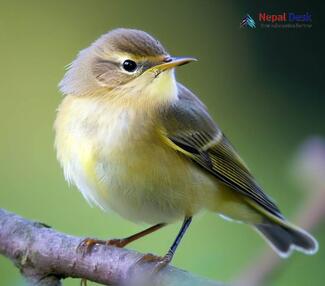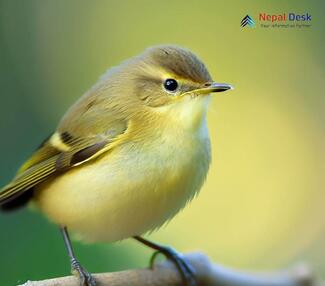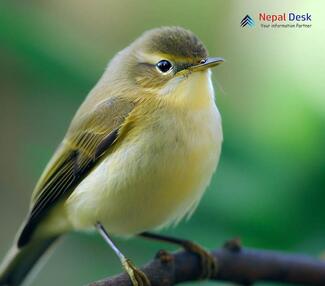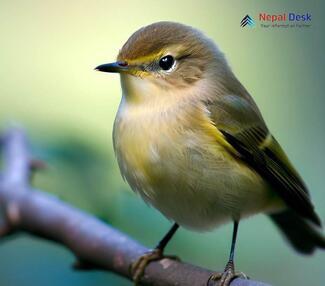The common chiffchaff (Phylloscopus collybita) is a small passerine bird best recognized by its onomatopoeic namesake spring song. As a leaf warbler, it forages insects among treetop foliage across a breeding range spanning Eurasia. come winter, this songster migrates south up to sub-Saharan Africa before returning northwards to breed in subsequent seasons. Such extensive annual travel is aided by specialized adaptations encoded in its DNA over evolutionary timescales.
Taxonomically, the common chiffchaff is classified within the order Passeriformes – the largest grouping of birds worldwide with over half of the avian species. More specifically, it belongs to the family Phylloscopidae (Old World insectivorous warblers), the genus Phylloscopus (small leaf warblers), and the species Phylloscopus collybita.
Genetically, the common chiffchaff exhibits a diploid chromosome number of 2n=80 typical of most songbirds. Its estimated 1.4 billion base pair genome reflects shared evolution with related passerine migrants, endowing anatomical gifts like efficient fat storage to power long flights.
So whether judged by classification or its innate biological composition, the common chiffchaff’s taxonomy and genetics underpin its ecological capacity for success across an extensive range in northern forests and tropical wintering locales alike.
Flying Behaviour
The common chiffchaff exhibits some distinctly energetic flight patterns. It flaps in bursts of speed, interspersing rapid wing beats with short glides as it darts about foraging along branches and leaves. Its flight style gives an impression of constant motion, almost frenetic at times.
While hunting insects, common chiffchaffs make primarily short, low flights moving between trees or vegetation in forests and thickets. They cover little ground at a time, methodically working an area by fluttering and hopping through branches versus soaring overhead.
However, common chiffchaffs are capable of hovering in place when they spot prey items atop foliage or branches. They stall midair, wings beating to sustain position, snatch their target, and then continue on their way a moment later. This hover-hunting illustrates remarkable aerobatic skills on a small scale.
In general, though, common chiffchaff flight revolves around frequent short distances near cover rather than spectacular aerial feats. But their energy and dexterity traversing even local tree canopies give hints to the stamina powering this species' extraordinary migratory journeys twice annually across continents.
Ecological Importance
Insect Population Control
Common chiffchaffs provide helpful pest control services in forest ecosystems. They feed almost exclusively on small insects like aphids, mosquitoes, midges, and other abundant invertebrates that could otherwise damage trees during population blooms. Their insectivorous diet helps suppress outbreaks.
Nutrient Cycling
Chiffchaffs also contribute key nutrients back into food chains. As prey for larger forest predators like hawk and owl species, common chiffchaffs pass biomass from lower insect levels up to higher trophic organisms through predation. Loss of feathers and bodies also transfers carbon and nitrogen compounds into the soil to fuel plant growth.
Seed Dispersal
Additionally, common chiffchaffs incidentally spread plant seeds as they forage. Tiny seeds cling to feathers or mud on feet can then be transported long distances to new colonization sites that expand vegetation distribution. This aids wider forest regeneration over time.
So while a small bird, the common chiffchaff’s insectivory, nutrient recycling capacity, and inadvertent seed dispersal services demonstrate disproportionately significant ecological influence on forest community structure and broader ecosystem function.
Identification
Upon first glimpse, the diminutive common chiffchaff nearly blends into the canopy, its muted olive and brown-toned plumage acting as ideal camouflage amidst the leaves. Yet despite barely spanning five inches in length, a few marked traits stand out - quite literally in the case of its namesake - that distinguishes this tiny songster.
A conspicuous bright white stripe arches boldly over each eye, contrasting a crescent of darker grey feathers along the ear coverts and nape. These striking “eyebrows” create delicate warbler facies framed by colorful avian accessories. In flight, its rounded body shape and short wings give a plump profile lacking streamlining. Up close, creamy yellow hues tinge the underbelly and undertail coverts, complemented by verdant olive upperparts and a thin pointed bill perfect for snatching moths and midges crossing its path.
Its voice also gives away the identity of the common chiffchaff well before one can spot it flitting through the trees. A repetitive “chiff-chaff-chiff-chaff” rings out - an eponymous song straight from the pages of an ornithological etiquette handbook. And frequently a sharp “hweet” call punctuates the canopy conversation where other warblers contribute their less recognizable remarks. So with a diversity of identifiable visual and vocal signposts marking its presence, the common chiffchaff offers a welcoming introduction to the avian delights awaiting discovery in Eurasia’s summery forests.
Nesting Behavior
Common chiffchaffs demonstrate immense dedication in constructing fresh intricate nests each spring across their breeding grounds. The task falls almost solely to the female over 5-7 days as the male perches guard. She alone weaves an architectural marvel from nearby natural materials measured precisely to her petite frame. A typical nest spans 5-6 cm across, domed with a side entrance hole no more than 3 cm wide – snug quarters for delicate eggs and cotton-like chicks soon to inhabit its walls.
In the temperate oak and rhododendron woodlands of Nepal specifically, cobwebs, dried bamboo leaves, moss, shed snakeskin, and soft tree bark become a female’s construction tools. Placing nests low amidst concealing ferns or thickets no more than a few feet up, she deftly incorporates insulating elements inside while fortifying the external structure sufficiently to protect contents even when parents briefly leave seeking food. The result provides sanctuary from Himalayan storms and prowling eyes alike for offspring still flightless themselves.
Each spring this procedure repeats, with last year’s cradles left abandoned. Sparing herself no luxury, the faithful female chiffchaff continuously spends days reworking familiar wooded haunts into fresh feathered bastions where parents take turns keeping eggs or hatchlings warm while the other forages. Until their first migration that fall, her handwoven efforts shape the young chiffchaffs’ entire world.
Breeding
In early spring, male common chiffchaffs migrate north to lower-altitude Nepali broadleaf forests first, establishing prime nesting territories through persistent song displays that both ward off competitor males and attract migrating females. Once paired, the monogamous mates construct an enclosed domed nest over 5-7 days, with the female gathering and weaving together local materials like foliage, moss, and feathers using spider silk. Inclining git placement near the ground in dense vegetation aids security.
The female then lays a clutch of 4-7 creamy white eggs marked with reddish-brown spotting solely incubating them for 13-14 days while relying on the male to provision food. Both parents continuously gather insects to feed hatchlings until they fledge around day 12. For up to 2 subsequent weeks, the adult pair maintains close contact instructing juveniles in skills like self-feeding essential for surviving the longer southbound migration. Through these coordinated parenting efforts, common chiffchaffs ensure the suitability of current and next generations facing niche challenges specific to Nepali forests and seasonal movements.
Feeding Habit
The common chiffchaff exhibits an insectivorous diet, consuming small invertebrates like midges, mosquitoes, spiders, caterpillars, and aphids representing convenient wooded prey sources they actively pursue.
Their foraging behavior primarily involves methodically gleaning foliage of broadleaf trees and shrubs, fluttering and hovering while searching leaves, branches, and bark crevices for movement. Upon sighting an insect, the common chiffchaff darts out to snatch it midair with its slender pointed bill before returning to its scanning perch. This allows efficient working in a hunting territory by minimizing unnecessary flight.
Additionally, during warmer months, aerial insects like flies and winged ants offer bonus nutrition captured during short sallies into the open air above canopy level, often initiated from a mid-height vantage showcase favored perch site. Common chiffchaffs will opportunistically target seasonal hatches and swarms providing abundant protein when available.
So from actively gleaning the trees to capitalizing on cloaking winged quarry, the common chiffchaff’s dietary adaptation allows maximum exploitation of small flying insect niches across woodland ecosystems. Such dietary specialization supports thriving populations on breeding grounds and sustains their long migrations.
Migration
Each spring, common chiffchaffs migrate north to their Nepali lower-altitude temperate forest breeding grounds generally between late March and early May. First, the adult males move up from wintering areas in India and Southeast Asia, followed by females about a month later. Flitting predominantly at night in loose flocks of up to a few dozen, they cover up to 400 kilometers in a single flight traveling at speeds around 50 km/hr. Scientists estimate they navigate by cues like star patterns visible at dusk and the earth's magnetic field sensed biologically.
By September after breeding, the adult and juvenile common chiffchaffs have dispersed up to 2500 meters of elevation. They start descending towards the southern Indo-Gangetic plains and eventually more tropical zones over the following weeks. Nocturnal travel during detailed migration likely involves sustained 2 to 6-hour flights to efficiently cover hundreds of kilometers by morning while avoiding heat exhaustion. Ancestors' wisdom guides the optimal geographic routes and timing honed through the ages.
Of Asian breeding common chiffchaffs, an estimated 2% overwinter in Myanmar, Vietnam, and neighboring regions. One recovered banded bird astonishingly reached South Africa demonstrating the species' underlying genetic capacity for immense solo voyaging. These Nepali-born leaf warblers thus transform from reclusive rainforest dwellers into global wanderers compelled by eons-old seasonal rhythms.
Habitat and Hotspot
Common chiffchaffs occupy a breeding range within Nepal spanning from 1,000-meter elevations in lower hill broadleaf forests up to higher elevation temperate woodlands approaching treeline at 2,500 meters. Prime habitat includes semi-open, sloping deciduous oak, maple, and rhododendron stands with dense shrubby undergrowth that aids nest concealment and insect volumes to feed chicks. Wetlands and streams provide additional dipteran and odonate prey abundance.
By September, post-breeding dispersal away from remote high-elevation sites down to 1,500 meters begins, shifting towards subtropical forests for the wintering period. Winter habitat spans the lowland Terai grasslands up through lower hill sal and pine stands. Those individuals that overwinter locally likely occupy wooded foothills zones in central and western regions along the Indian border.
Key areas for spring and summer common chiffchaff sightings include oak-dominated stands within Shivapuri Nagarjun National Park near Kathmandu, the extensive temperate broadleaf tracts of Makalu Barun National Park eastwards, and humid mid-elevation rhododendron woodlands accessed along the Annapurna Circuit trekking route. Winter hotspots concentrate near lowland reserves like Koshi Tappu Wildlife Refuge extending along the Indian border.
Global Range
The common chiffchaff breeds across a vast range spanning temperate and subtropical wooded habitats across Europe and Asia. Scientists estimate the ancestral origins of Phylloscopus warblers like the chiffchaff trace back to forested refugia on the Mediterranean islands and nearby mainland during glacial periods over 10 million years ago. From here, populations expanded north and east in successive warmer interglacial periods as broadleaf woodlands spread.
Today the common chiffchaff occupies a breeding distribution stretching from Western Europe across Scandinavia and Eastern Europe clear to the Pacific coasts of Russia and Japan. It winters broadly south of this range throughout tropical Africa, the Middle East, Indian Subcontinent, and Southeast Asia. Such an extensive migratory reach attests to the species' adaptive capacity to shift vast distances targeting seasonal insectivory opportunities.
Interestingly, genetic analyses reveal that chiffchaffs in Western versus Eastern Europe show slight evolutionary differentiation, pointing to past isolation in discrete glacial refugia. Similarly, Siberian populations appear distantly distinct from more westerly groups. Still, the continuity and overlap of breeding and wintering distributions reflect a resilient specialty balancing opportunism within a fluctuating environmental context over millennia.
So whether transpiring through the primeval Caucusus oak groves that helped spark its speciation, or modern clearings in Norwegian spruce forests at the leading fringe of seasonal suitability, the common chiffchaff manifests dominion across an expansive range both longitude and latitude - a diminutive monarch whose delicate song still brightly heralds spring’s unfolding canopy banquet.
Sexual Dimorphism
Males and females appear nearly identical to casual observation. Subtle differences detectable on careful inspection include slightly paler brown upperpart tones in females along with faint buff hues along the flanks compared to the male’s pure white. Experienced observers may also note males average slightly larger, but extensive overlap prevents definitive determination by size alone.
Similar Species
The willow warbler appears very similar, occupying the same woodland niche. Distinguishing features include a longer primary projection relative to tertials and a faint pale upper wing panel on the willow warbler. Also, listen for the willow warbler's descending cadenced call compared to the monotonous pitch of the chiffchaff. Yellow-browed warblers also frequent similar temperate habitats across Eurasia but feature bold yellow supercilium stripes contrasting green upperparts.
So while casual observation likely dismisses common chiffchaffs as just another olive-toned “leaf warbler”, their distinctive namesake vocalizations confirm identity even when lacking a clear view amidst the fluttering canopy flock. Subtle variations around wing formula, underpart tones, and call notes to distinguish among superficially identical Phylloscopidae flockmates.
Spotting and Status
With conservative global population estimates hovering near 75 million to 150 million mature individuals dispersed broadly across Eurasia, the IUCN Red List assessment places the common chiffchaff in the lowest risk Least Concern category as of the 2018 analysis. However within Nepal specifically, local wintering subpopulations likely number far fewer at around 50,000 overwintering migrants and summer residents combined. These groups require closer research and monitoring for range adjustments driven by regional climate or habitat shifts falling outside of embedded historical evolutionary parameters.
Peak activity drives common chiffchaffs up to 2500 meter spring breeding elevations by early April, where the males’ endless “chiff-chaff-chiff-chaff” resonating from high perches signals nest construction underway. Ideal sites feature partially open slopes with dense understory of Rhododendron arboreum or oak permeated by Hydrangea shrubs along shadowed stream banks - precisely where abundant spring tailings offer sufficient caterpillars and crane flies to satisfy the several dozen daily meals both parents relay from dawn past dusk provisioning hatchlings.
Come September, winter restlessness pushes dispersal downhill and then south by October through valleys like Langtang where mixed flocks flurry in Calliope cries, genetic memory steering cohorts eventually beyond Nepal’s borders to overwinter perhaps in Assam’s forests should Brahmaputra floods subside adequately. There the chiffchaffs subsist almost hidden save revealing identification by signature vocal duets peppering India’s teak stands little altered by the precise rhythms conducted along ancestral flyways preceding human reckoning yet increasingly threatened by it.




